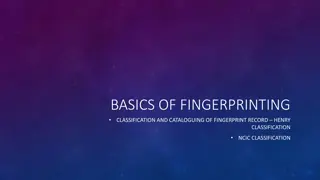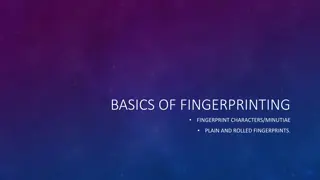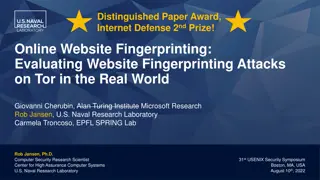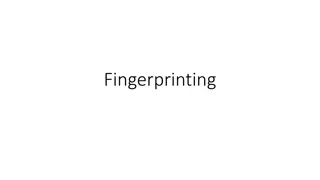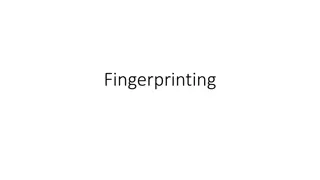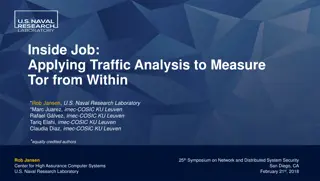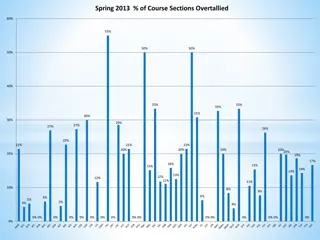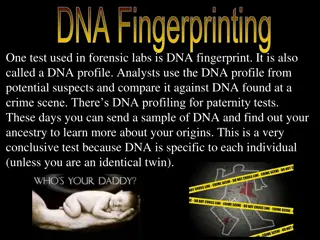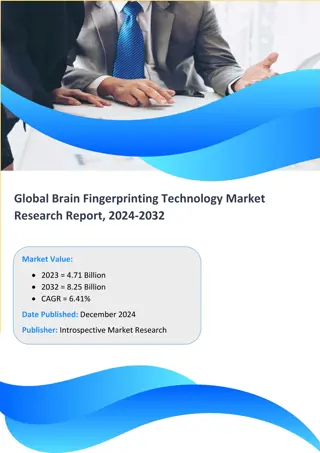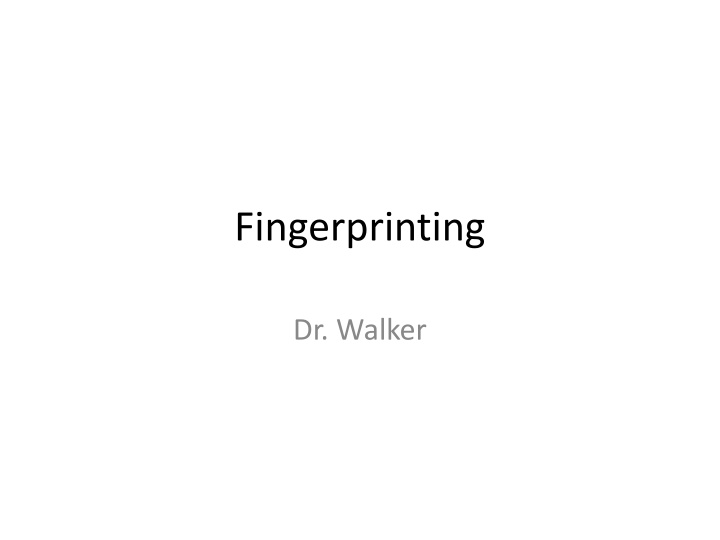
Fascinating Insights into Fingerprints and Their History
Delve into the intriguing world of fingerprints with details on their origin, formation, uniqueness, and historical significance. Discover how fingerprints are used for identification, their permanence, and the development of classification systems. Explore databases like IAFIS and UIAI, containing millions of prints, shaping modern forensic practices.
Download Presentation

Please find below an Image/Link to download the presentation.
The content on the website is provided AS IS for your information and personal use only. It may not be sold, licensed, or shared on other websites without obtaining consent from the author. If you encounter any issues during the download, it is possible that the publisher has removed the file from their server.
You are allowed to download the files provided on this website for personal or commercial use, subject to the condition that they are used lawfully. All files are the property of their respective owners.
The content on the website is provided AS IS for your information and personal use only. It may not be sold, licensed, or shared on other websites without obtaining consent from the author.
E N D
Presentation Transcript
Fingerprinting Dr. Walker
Write bold Background Where do fingerprints come from? The friction ridge pattern is determined in the womb (before birth) by the dermal papillae, cells between the surface and lower layers of the skin. The papillae are roughly 2 mm below the surface and form a negative of the fingerprint. Cutting into the papillae leaves a scar, but does not change the print.
Write bold Background How do fingerprints occur? Friction ridge skin that deposits oil, perspiration, dirt on object touched Fingerprints are 99% water Cold hands or recently washed hands leave practically NO secretion
Write all Background What makes fingerprints useful? All fingerprints are unique Fingerprints cannot be changed. Fingerprints display patterns that allow them to be classified.
Cant be changed? Only instances of changing fingerprints are: injuries or surgery causing deep scarring diseases such as leprosy damaging the formative layers of friction ridge skin Can t cut deep enough to fully remove skin for fingerprinting
Write bold History 1880 Henry Faulds Discussed fingerprints as a means of personal identification, and the use of printers ink as a method for obtaining such fingerprints. Credited with the first fingerprint identification of a greasy fingerprint left on an alcohol bottle. 1888 Sir Francis Galton Published his book, "Fingerprints", establishing the individuality and permanence of fingerprints. His book included the first classification system for fingerprints.
Write bold History 1896 - Sir Edward Richard Henry Developed the print classification system that would later be used in Europe and North America. 1918 Edmund Locard 12 point match Locard wrote that if 12 points were the same between two fingerprints, it would suffice as a positive identification. This is the most common standard for print matches today
Write bold Databases IAFIS FBI s database 60 million prints contained (to date) Collected since 1924, automated since 1974 UIAI India Current database, known as AADHAAR, has over 200 million prints Hopes to have 600 million by 2014
Write all Who Gets Fingerprinted? Criminals fingerprints Federal job applicantsemployees Military Aliens (aka non-residents) Anyone else who wants them on record
Features of Fingerprints http://upload.wikimedia.org/wikipedia/commons/0/06/Fingerprint_Loop.jpg http://upload.wikimedia.org/wikipedia/commons/thumb/c/c5/Fingerprint_Arch.jpg/200px-Fingerprint_Arch.jpg http://upload.wikimedia.org/wikipedia/commons/thumb/4/49/Fingerprint_Whorl.jpg/200px-Fingerprint_Whorl.jpg From left: Arch Loop Whorl circular pattern within print These are the basic features
Features of Fingerprints Tented Arch Distinct angles within arch Twinned Loop Distinct loops going in two separate directions Central Pocket Loop Whorl within a loop
Features of Fingerprints Lateral pocket loop Distinct loops in two different directions Composite Multiple distinct features Accidental Multiple features, pattern within patterns
Write all Types of Fingerprint Evidence Latent Small amounts of grease, sweat, and dirt on surface of skin Patent (aka contaminated) Dirty finger (dust, blood, ink, oil) Plastic Left in paint, wax, chocolate, dust, etc. Leaves a NEGATIVE impression of friction ridge
Write all Fingerprinting Reagents Reagent Reacts With Used On? Resulting Color Iodine Porous or non- porous Ninhydrin Porous Silver Nitrate Porous Cyanoacrylate Non-porous
Write all Fingerprinting Reagents Reagent Reacts With Used On? Resulting Color Iodine Adheres to sebaceous (fatty) material Porous or non- porous Yellow to Brown Ninhydrin Reacts with amino acids Reacts with salts Porous Ninhydrin (purple) Brown or black Silver Nitrate Porous Polymerizes materials in print used for preservation Cyanoacrylate Non-porous White (can be enhanced)
Write all Fingerprinting Reagents Reagent Reacts With Used On? Resulting Color Regular Powder Non-porous and porous. Depends on exact powder and surface Amido black Bloodstained specimens. Blue - black Luminol Chemical reaction with hematin. Presumptive test for blood. Titanium Dioxide Chemical reaction Use on plastic, electrical & duct tape
Write all Fingerprinting Reagents Reagent Reacts With Used On? Resulting Color Regular Powder Adheres to moisture and lipid components. Non-porous and porous. Depends on exact powder and surface Amido black Chemical reaction with protein in blood. Bloodstained specimens. Blue - black Luminol Chemical reaction with hematin. Presumptive test for blood. Luminescence (view with fluorescent light) Titanium Dioxide Chemical reaction Use on plastic, electrical & duct tape White
Write all Collection Procedure Photograph all prints prior to collection!! Use cellophane tape over prints Prevent air pockets Smooth gently over print with finger. Slowly remove from surface Apply tape to fingerprint backing card that has been filled out BEFOREHAND. Use appropriate color of backing card
Sources http://onin.com/fp/fphistory.html http://ridgesandfurrows.homestead.com/inde x.html https://www.fbi.gov/services/records- management/foipa/privacy-impact- assessments/iafis




